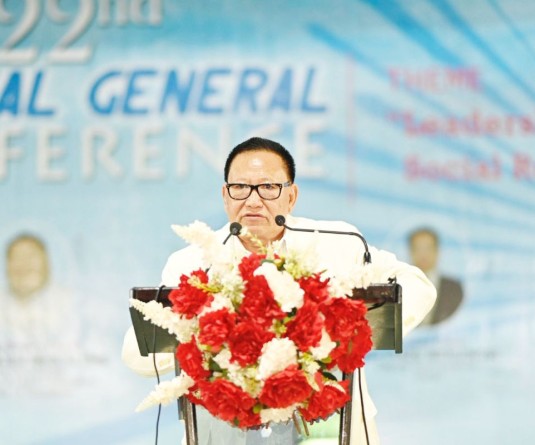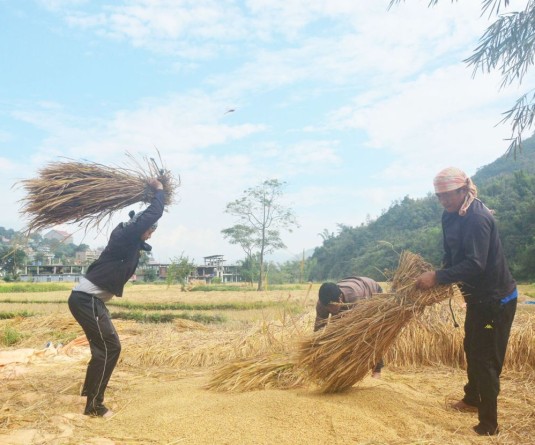Officials and participants during the 2nd Nagaland Harm Reduction at Hotel Vivor on March 28. (Morung Photo)

Morung Express News
Kohima | March 28
With the alarming situation of both substance abuse and HIV scenario in Nagaland, awareness of substance abuse and HIV need to be included in the curriculum/syllabus, in the elementary education, Sunday school etc to prevent young adolescence from entering into the world of drugs and to prevent them from being infected with HIV & AIDS.
This concern was shared by Y Kikheto Sema, Commissioner & Secretary, H&FW who was inaugural guest of honour at the 2nd Nagaland Harm Reduction conference held under the theme ‘Making a difference’ at Hotel Vivor on March 28.
Recalling the menace of alcohol and substance abuse 32 year back, Sema viewed that ‘the imposition of Nagaland Liquor Total Prohibition (NLTP) Act led to increase of heroin use.’ Further, the interruption of the golden triangle led to the emergence of use of pharmaceutical drugs then to sunflower drugs today.
He expressed grave concern on the data of ‘National survey on extent and pattern of substance use in India 2019’ where Nagaland is among the top 10 in the country among People Who Inject Drugs (PWID), opioids user is at 25.2%, sedative users are at 9.6%, cannabis users are at 4.6% and alcohol users 8.1%.
HIV situation in the State
Highlighting HIV scenario in the state, Sema referring to NACO HSS Plus report 2021 informed that the ANC prevalence is at 1.61% against the national average of 0.22, which is the highest in the country.
Besides, the adult prevalence rate among 15-49 years of age is at 1.36% against the national average of 0.21 which is the second highest in the country. Only 16% of the youth (15-24) have comprehensive knowledge of HIV & AIDS while 45% of youth does not know source of condom and 37% of sexually active youth engaged in high-risk sexual behaviour (NFHS-IV).
The data of December 2022 in the State indicates that about 21% of HIV positive cases are those below the age of 24, while the major route of HIV transmission is through Sexual (87%) and Injecting (6.7%) routes. The HIV Sentinel Surveillance of 2021 shows a worrying trend of increase in HIV prevalence amongst the IDU (from 1.3% to 2. 24%), informed Sema.
Nonetheless, he appreciated the efforts of all the NGOs and field team who with the support of NSACS, NACO, development partners and stakeholders who have been able to bring down the HIV prevalence amongst IDU from 39% prevalence in 1991 to 2.4% prevalence by 2021.
With the alarming situation of both substance abuse and HIV Scenario in the State, he pressed on the need for the churches, civil society organisation, NGOs, media for greater collaboration and work in synergy to prevent young adolescence from entering into the world of drugs and to prevent them from being infected with HIV & AIDS.
‘In Nagaland, HIV is not only confined to the so-called high risk groups but has reached to general population. Let us commit to remove all barriers access HIV services, stigma and discrimination and ensure equality and good quality to all,’ appealed Sema.
Special guest, Dr Melissa Nyendak Director, Division of Global HIV & TB, CDC India, US Government emphasised on the need to improve existing linkages, build new partnerships and strategies, create and expand networks and referrals to ensure equity and accessibility.
She suggested some steps that can contribute to end HIV as public health threat through evidence based strategies to be implemented effectively, to involve affected communities – ‘all hands on the deck’ approach and the decision on how to expand the good practices to ensure continuous quality improvement.
Negligible progress in State
With the alarming use of Sunflower drugs in State, Dr Akuo Sorhie, Project Director, NSACS said the vulnerability of the State is much more so because of its strategic geo-political location and proximity to the so called golden triangle since then. “It is a matter of grave concern that we look at the vulnerability both in terms of the increasing drug abuse and HIV amongst the injecting drug users,” said Dr Sorhie.
Nagaland’s combat against the menace of drugs and its consequences in the form of HIV & AIDS and other sexually transmitted Infections (STIs) have made negligible progress in terms of HIV prevalence rate till today, she said.
Reminding that Nagaland still stands second highest in Adult HIV prevalence rate in the country, with 1.36% which is more than 6 times higher than the National Average, Dr Sorhie asserted ‘prevalence of 1% or more indicates towards well established epidemic in the general population should be of great concern for everyone.’
“For the fact that HIV Infection is not curable as of today, but for the fact that HIV is preventable, won't it be a crime to allow one single person/one single child to get infected with HIV due to ignorance or because we failed to intervene or rather because we failed to reach to them with the correct information in terms of harm reduction services in time?” she asked with grave concern.
Towards this end, she appealed to the policy making bodies to take pro-active role as Nagaland continue to battle against the illicit drug use and HIV & AIDS in the State.
She also urged everyone to take this mission as an individual responsibility and concertize all the citizens that ‘drug abuse and HIV & AIDS is far from over even as we race against time towards attainment of United Nations' Sustainable Development Goals 3.3 of ending HIV & AIDS epidemic as a public health threat by 2030.’
The two-day programme jointly organised by Kripa Foundation, PATH, NSACS, NUN, NNagaDAO and CAD Foundation includes technical and discussion session on various topics. It will conclude on March 29.





